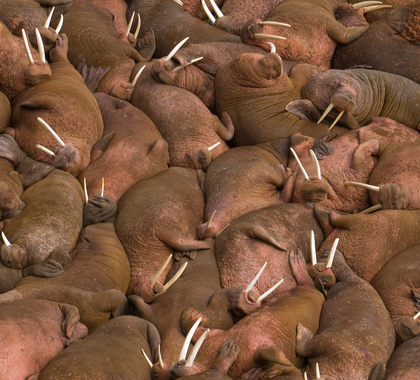In response to a court imposed deadline, the United States Fish and Wildlife Service (FWS) announced on October 5, it will not list the Pacific walrus or 24 other species as threatened or endangered under the 1973 Endangered Species Act. The court ordered deadline and the decision was in response to petitions filed by the Center for Biological Diversity (CBD) and other groups forcing FWS to decide whether to list the 25 species in question as endangered or threatened.
In rejecting the petitions for listing, FWS said in a statement accompanying its decision its review determined none of the 25 species warranted being listed as endangered or threatened at this time after “we considered and thoroughly evaluated the best scientific and commercial information available regarding the past, present, and future stressors and threats.”
The Washington Times reports the Pacific walrus decision drew cheers from Alaska’s congressional delegation, who believed listing the walrus as endangered would both be based on bad science and would harm Native Alaskans.
“I welcome the USFWS’s determination to manage wildlife through measurable and scientific methods,” said Sen. Dan Sullivan (R-AK) to the Times. “Responsibly harvesting and utilizing Pacific walrus is a traditional and vital subsistence activity for Alaska Natives.”
Walrus Adapts
The CBD argued the walrus’ continued survival was threatened by a decline in sea ice due to human caused climate change. FWS determined walrus populations had proved to be quite adaptable and were not threatened by any loss of sea ice.
“While walruses use sea ice for a variety of activities, including breeding, birthing, resting and avoiding predators, they have shown an ability to adapt to sea ice loss that was not foreseen when the Service last assessed the species in 2011,” FWS said in a statement. When sea ice is lacking, the Pacific walrus, as it always has, breeds and rests along coastal shores, where they are no more vulnerable to predation than they are on ice.
Rep. Don Young (R-AK) told the Times FWS’s decision “recognizes the health and stability of Alaska’s walrus population and ignores the extreme political pressures often associated with new Endangered Species Act listings.”
“There are often numerous unintended consequences associated with new ESA designations, including those that undermine stewardship done at the state, local and tribal level and ignore the needs and firsthand knowledge of local communities,” Young said. “We’ve seen it before, where field-tested and empirical data was ignored in favor of the environmentalist agenda to limit resource development in Alaska. I’m glad to see that didn’t happen this time.”
Even absent protections afforded by the Endangered Species Act, the Pacific walrus is still protected by the 1972 Marine Mammal Protection Act.
Safe For The Foreseeable Future
The other 24 species FWS determined didn’t merit listing at this time included 14 Nevada springsnails, the Florida Keys mole skink (a lizard), two birds, a crayfish, a snake, a toad, and the Northern Rocky Mountains fisher.
Despite the fact the beach and coastal forests habitat of the mole skink were hit hard by Hurricane Irma, FWS determined the skink’s habitat could shrink by as much as 44 percent while still allowing its populations to thrive “into the foreseeable future,” meaning at least until 2060.
H. Sterling Burnett, Ph.D., ([email protected]) is the managing editor of Environment & Climate News.





